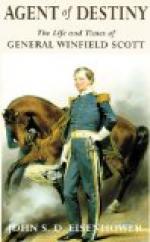The day before the occurrence of the affair just mentioned he landed at Fort Matilda, commanding a narrow place on the river, where he gained possession of the fort. The expedition which was announced for the conquest of Canada was, on November 12th, abandoned by its leader and projector, General Wilkinson, who commanded a retreat. This occurred when Scott was fifteen miles in advance of Chrysler’s Field, there being no body of British troops between him and Montreal, and the garrison at the latter place had only four hundred marines and two hundred sailors.
Wilkinson’s defense for his failure was that General Hampton had refused to join him at St. Regis for fear of lack of provisions and forage.
After the events just related, Colonel Scott was engaged in preparing the new levies of troops for the field and arranging for supplies and transportation for the next campaign.
On March 9, 1814, he was appointed to the rank of brigadier general, and ordered to join General Jacob Brown, commanding general of the United States army, then moving toward the Niagara frontier. On the 24th General Brown marched to Sackett’s Harbor, where Scott established a camp of instruction. On assembling of the army at Buffalo, Scott was assigned to the command of the Ninth, Eleventh, and Twenty-fifth Regiments of infantry, with a part of the Twenty-second Regiment and Captain Towson’s company of artillery. In addition to this command there were at this time at Buffalo the commands of Generals Porter and Eleazer Wheelock Ripley. The whole force was placed in camp under General Scott’s immediate direction. In the latter part of June General Brown returned to Buffalo, and on the morning of July 3d Scott’s brigade with the artillery of Major Jacobs Hindman, crossed the river and landed below Fort Erie, while Ripley’s brigade landed a short distance above. Fort Erie was invested, attacked, and soon surrendered, and on the morning of the 4th Scott’s brigade moved in advance in the direction of Chippewa. He was engaged for a distance of sixteen miles in a running fight with the British forces under the Marquis of Tweedale. Toward night the Marquis of Tweedale crossed the Chippewa River and joined the main army under General Sir Phineas Riall. Scott then took position on a creek some two miles from Chippewa. On the east was the Niagara River and the road to Chippewa, while an the west was a heavy wood. Between the wood and the river were two streams—the Chippewa and Street’s Creek. General Riall, the British commander, was posted behind the Chippewa, flanked on one side with a blockhouse and a heavy battery on the other.




